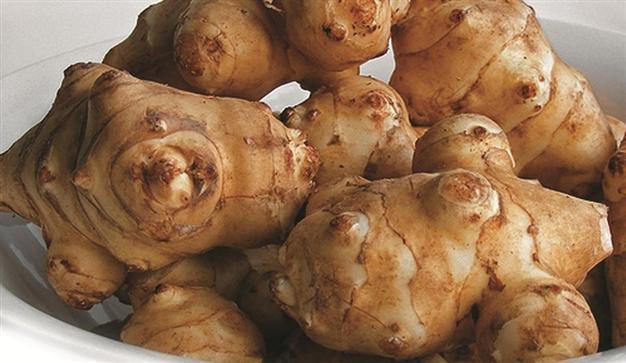Ground apples?
Aylin Öney Tan - aylinoneytan@yahoo.com
 The title may suggest that late Jerusalem artichokes must be one of the vegetables that have stirred up much confusion by their name and use in history. The vegetable is actually the tuber of a pretty yellow flower from the sunflower family, which is native to North America and Canada. Like peppers, potatoes and tomatoes, it is a gift of the Columbian exchange to the cuisines of the old world. In 1607, it was first brought to Europe from Nova Scotia, Canada by the French explorer Samuel de Champlain.
The title may suggest that late Jerusalem artichokes must be one of the vegetables that have stirred up much confusion by their name and use in history. The vegetable is actually the tuber of a pretty yellow flower from the sunflower family, which is native to North America and Canada. Like peppers, potatoes and tomatoes, it is a gift of the Columbian exchange to the cuisines of the old world. In 1607, it was first brought to Europe from Nova Scotia, Canada by the French explorer Samuel de Champlain.Because the flower of the plant turns towards the sunlight, the Italians called it “girasole articocco,” meaning “sunflower artichoke.” To them it resembled the sunflower, “girasole,” and tasted similar to artichokes. The English name Jerusalem artichoke is an alteration of this Italian name, having nothing to do with either Jerusalem or actual artichokes. For the Germans it was more likened to apples, thus called Erdäpfel, meaning ground apples. The Germans are good at making the most of fruits, especially potent spirits like schnapps, so it came naturally to them to make a brandy with this new apple! The specialty of Baden-Württemberg in southwest Germany is called Erdäpfler or Topinambur or just Topi. The latter two names are from their French neighbors, who preferred to call the new vegetable by the exotic name “topinambur,” referring to the Brazilian tribe Topinambá. This again, like the Jerusalem connection, was a mere mistake dating back to 17th century, when a representative of the tribe was visiting the Vatican and the Pope was first introduced to samples of the tuber. Both were regarded as exotic visitors and the connection was made instantaneously. Following the Papal influence, the Italians, French, Spanish, Romanians and Russians adopted the name. Unfortunately, the very original Algonquin name of the vegetable – kaisukpenauk - never showed up in any language.
In England, pies made with the newly-invented tuber were a taste fit for the Queen. With its nutty flavor and crunchy texture reminiscent of apples and pears, it was first perceived as a sweet ingredient and used in pie fillings mixed with dates, sultanas, ginger and wine. However, it was soon discovered that the tuber was very easy to grow, making it a starchy staple to feed the masses. It was also used as fodder to feed pigs. This made the poor chokes lose their royal status in the vegetable world, yet they did not become a favorite of crowds, perhaps because of their windy nature.
The Jerusalem artichoke has a peculiar characteristic. It contains a starch that is indigestible by humans. The undigested inulin causes wind in the intestines, making the consequences of eating Jerusalem artichokes quite challenging for some. But there is a secret to it. The late harvest tubers contain way less of the starch; as the plant struggles to cope with the cold climate, it eats up its own starches.
In Turkey, we follow the line of the Germans and call Jerusalem artichokes “yerelması,” an exact translation of “ground apples.” Beypazarı, close to Ankara, is the epicenter of its cultivation, with the tubers left in the ground throughout the icy winter and only harvested upon demand. There seems to be only one popular dish in Turkish cuisine using them, “zeytinyağlı yerelması,” which is made with olive oil with onions, some carrots and a handful of rice garnished with fresh dill. Turkish cooks have yet to discover the various versatile ways to cherish the ground apple.
From soups to desserts, the sunny chokes are fit for every table, either royally treated or humbly munched, and it is an earthy treat not to be missed.
Bite of the week
Recipe of the Week: This soup is velvety smooth even without the addition of cream. Finely chop 1 medium onion and sauté in 3 or 4 tablespoons of extra virgin olive oil together with 2 teaspoons of coriander seeds and 1 teaspoon of whole cumin seeds. When the onions are translucent and soft, add ½ kg peeled, chopped Jerusalem artichokes and continue to sauté till slightly caramelized. Add 3 cups of water and 1 teaspoon of salt; cover and cook until very soft. Add 2 cups of milk and whizz in a blender or hand held robot. If you like, serve with crunchy choke chips. To make the chips, slice a few Jerusalem artichokes very thinly, then pat dry to remove moisture and deep fry in olive oil. When golden, transfer on to paper towel and salt to taste. Fork and Cork of the Week: This week is a celebration of French cuisine all over the world. Mark the date March 19, and try to find a locale close to you celebrating the day. “Goût France/Taste France” is celebrated with 1000 chefs and 1000 menus over five continents, the same day, all over the world. In Ankara, the table to reserve is at the Marco Polo restaurant at the Ankara Hilton. The menu of six courses will be accompanied by matching French wines. It is also for a good cause, as 5 percent of the sales will be donated to Dr. Sami Ulus Children’s Hospital. For details & reservations call: 0530 566 27 11












